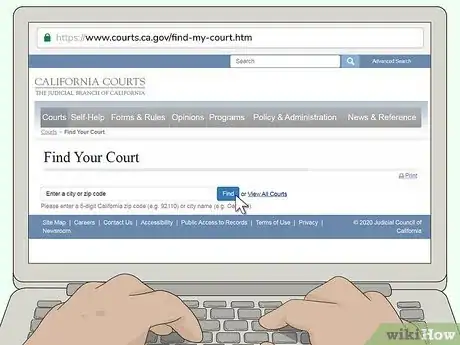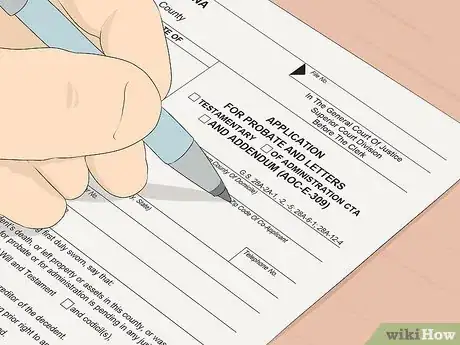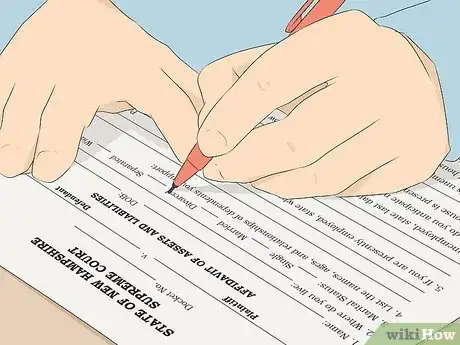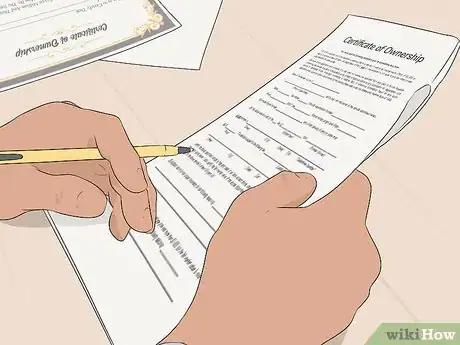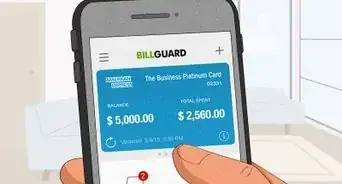This article was written by Jennifer Mueller, JD. Jennifer Mueller is an in-house legal expert at wikiHow. Jennifer reviews, fact-checks, and evaluates wikiHow's legal content to ensure thoroughness and accuracy. She received her JD from Indiana University Maurer School of Law in 2006.
There are 8 references cited in this article, which can be found at the bottom of the page.
This article has been viewed 24,750 times.
The death of a parent can be a traumatic and difficult time. However, if they left you some of their property, you may need to go to court to get that property transferred into your name. The process you'll use varies depending on whether your parent had a trust or a will. If they left behind a small estate and didn't have a will or trust, you can use an affidavit to take control of the property without going through probate. Regardless of how you transfer the property, you can't get started until you have a copy of your parent's death certificate.[1]
Steps
Transferring Property out of a Trust
-
1Go over the trust documents. Typically, the trustee will send notice to you within a couple of months after your parent's death. This notice includes information about your parent's trust as well as a copy of the trust documents. These documents detail the property your parent left in the trust and lists the people who are beneficiaries of the trust.[2]
- Trust documents can contain a lot of complex language and legalese. If you don't understand the information in the trust documents, you might want to have the trustee or an attorney go over the documents with you.
-
2Contact the trustee named in the trust. If your parent's trust names someone as trustee, they will be responsible for settling the trust and distributing the assets. If your parent had a living trust in which they were the trustee, you'll be looking for the successor trustee.[3]
- If your other parent is living, they may be named as the trustee. If your parents were divorced, on the other hand, it's possible that you are listed as the trustee. However, if you are listed as a beneficiary of the trust, you can't also serve as trustee.
- Some trusts list an institution, such as your parent's bank, as the trustee. Most institutions have specific individuals that serve as trustees on behalf of the institution.
Tip: If you are listed as the trustee, hire an attorney with experience in trusts to assist you. They'll make sure you follow all the legal requirements and fulfill your duties as trustee.
Advertisement -
3Wait for the trustee to pay creditors and taxes. The trustee is responsible for sending notice to creditors and paying all the debts and taxes that are owed by your deceased parent. In some situations, this involves selling assets from the trust to pay what is owed. With the typical trust, this shouldn't take longer than a year.[4]
- For example, if your parent owed $100,000 and the only asset in the trust was a house, the house would have to be sold to pay your parent's debt. Any leftover money would go to the beneficiaries of the trust.
-
4Complete any necessary documents to transfer the property. The documents required to transfer property after all debts and taxes are paid depend on the type of property. For most personal property, no documents are required to transfer ownership of the property. However, you will need documents to transfer the ownership of real estate or titled property, such as cars or boats.[5]
- For example, if your parent left you their car, you would need the title for the car to transfer the ownership to your name. If the car was held by the trust, the title would be in the name of the trust. The trustee would fill out the title to transfer ownership from the trust to you.
Going through Probate
-
1Read your parent's will to determine what property was left to you. Reading your parent's will can be a difficult task mentally and emotionally, especially if the two of you were close. You might want to get a friend or loved one to sit with you as you read it. Generally, the will lists your parent's property and the specific items they want to leave to specific people, if any. Some wills are relatively short and simply leave all of the person's property to one person, while others are more detailed.[6]
- Sometimes it can be difficult to find your parent's will, especially if they didn't tell you where it was before they died. Check safe deposit boxes or other places where you know your parent kept important personal papers.
- Some people also file a will with the clerk of the county court. Although this isn't a legal requirement, it ensures that you can easily find the will. Call the county court in the county where your parent lived and find out if they allow people to file wills. If they do, they'll explain the procedure for retrieving your parent's will, if it's there.
- If you know the name of your parent's attorney, call them and ask them about the will. If they drafted your parent's will, they might have a copy of it.
Tip: If your parent has significant assets, such as real estate, you may need to go through the probate process even if your parent didn't have a will. If there's no will, distribution of your parent's assets is determined by state law.
-
2Calculate the value of your parent's estate. Courts have different requirements for probate depending on the value of your parent's estate. If your parent left few assets, you might be able to use simplified procedures that don't require as much time and effort as the full, formal probate procedures.[7]
- For this calculation, you're just looking for a ballpark estimate. Generally, if your parent owns real estate, they're probably over the threshold. However, if your parent only owns a vehicle and some personal property (such as furniture, clothing, and household goods), they likely fall below the threshold.
- The specific threshold for formal probate varies among states. However, it's typically over $50,000.[8] In some states, such as California, it's as high as $100,000.[9]
Tip: Assets that don't have to go through probate, such as life insurance policies or retirement accounts with a named beneficiary, aren't counted towards the value of your parent's estate for probate purposes.
-
3Identify the personal representative of your parent's estate. Your parent's personal representative is the person who will be responsible for the administration of their estate, including paying their creditors and distributing their property. If your parent has a will, they likely named the person they wanted to be their personal representative.[10]
- If the personal representative your parent named in their will is not available, see if your parent named an alternate. If they didn't, you'll have to determine who is willing to serve in this capacity. Choose someone who is mentally and emotionally prepared to take on this role.
- You can also hire a lawyer to serve as your parent's personal representative. However, this is usually a more expensive option than using someone who is a close friend or member of the family.
- Avoid naming someone who is listed as a beneficiary in the will as your parent's personal representative. For example, if you know that you're getting the majority of your parent's property, you probably shouldn't serve as their personal representative.
-
4Choose the correct probate court. Typically, you'll use the probate court in the county where your deceased parent lived. If your deceased parent owned property in a different county, you might also be able to use the probate court there.[11]
- For example, your parent might own a house in one county but spent the last few months of their life in a hospice in the neighboring county. In that situation, you would likely want to file your application in the probate court for the county where your parent's house is located.
- If you call the clerk of the probate court, they can help you figure out which court you should use. You may also be able to find information on the court's website.
-
5Submit your parent's will to the clerk of court. Some probate courts require you to submit the will you want to be probated before you file an application or petition to start the actual court process. Call the clerk's office. They'll be able to let you know if you need to submit the will and what the specific process is for doing that.[12]
- Usually, there will also be information about the process on the probate court's website.
- Typically, you need to bring the will to the clerk's office in person. You may also need to submit copies of the will. However, before you submit the will, make at least one copy for your own records.
-
6Complete an application for probate. The probate court you use will likely have a form that you can fill out if you're using simplified procedures. For formal probate, you'll typically have to hire an attorney to draft a formal petition.[13]
- You'll have to pay a filing fee when you file your application. These fees vary greatly from state to state and, in many states, even from county to county. However, they're typically a few hundred dollars. If you're filing the application yourself, you'll likely have to pay these fees out-of-pocket initially, but you can get reimbursed from your parent's estate.
-
7Hire an attorney to assist with the administration of the estate. If you were chosen as your parent's personal representative, you'll typically want to hire an attorney to help you. The attorney's fees are paid by your parent's estate.[14]
- If your parent doesn't have substantial assets or a lot of debt, the administration of the estate might be relatively simple. In that situation, you might not need to hire an attorney, but you still definitely want to talk to one. Most attorneys who specialize in estate planning offer a free initial consultation.
- If you are planning on hiring an attorney, it's a good idea to meet with 2 or 3 local attorneys so you can choose the one who best suits your needs. Also, make sure you pick someone you get along with because you're likely going to be working with them for at least a year.
Tip: Attorneys' fees for estate administration are typically determined by state law. In some situations, the judge might also order a set fee.
-
8Attend court hearings as necessary to distribute property. With simplified procedures, you typically only have to go to court once. However, if you end up needing formal probate, you'll likely need to attend several court hearings for the judge to approve the distribution of property.[15]
- Formal probate proceedings can take anywhere from 6 months to a year for more complex estates. Expect it to take longer if your parent had a lot of debt, or if they had a substantial estate with numerous investments.
Completing an Affidavit
-
1Create a list of heirs. List all of your parent's living relatives and show your relationship to them. If your parent died without a will, typically you need to be their next of kin if you want their property transferred into your name. If you are not the next of kin, or if you have other siblings, you'll need letters or affidavits from them stating that they have no interest in the property.[16]
- For example, if you have a sister and your parent has a brother who has 2 kids, you would typically list your uncle, 2 cousins, yourself, and your sister on your list of heirs. You and your sister would be considered your parent's next of kin, assuming your parent was divorced or your other parent was not living.
- If you aren't close to your parent's family and have no idea who is still living, there are ways you can publish a notice of their death calling for heirs to come forward. The clerk of the probate court will help you with this.
-
2Check with banks or other institutions for an affidavit form. Many banks and other institutions that might have control of your parent's assets have their own affidavit form. Using that form makes it easier to get your parent's property because the form includes all the information the institution needs to release the property to you.[17]
- For example, if your parent had a bank account, go to one of that bank's branches, explain the situation, and ask if they have an affidavit form for you to fill out.
- The website for your state court system might also have affidavit forms that you can use. Banks and other institutions will also accept these forms, provided all the information they need is included on the form.
-
3Fill out the affidavits that you need. The affidavit requires you to provide information about the death of your parent and any proceedings that are being conducted in court, or have already been conducted in court, regarding their estate. Typically, if you're transferring property using an affidavit, there won't be any court proceedings. You'll also need to provide details about the property that you want to be transferred to you.[18]
- If there are other heirs, they'll likely need to sign your affidavits as well. For example, if you have a sibling, they would need to sign the affidavit, even if you're the only one submitting it.
- If someone else signs the affidavit who won't be present when you submit the affidavit, typically their signature needs to be notarized, even if yours does not.
Tip: Not all states require these affidavits to be notarized. However, some banks and other institutions may require it, so generally, it's a good idea to go ahead and sign your affidavits in front of a notary.
-
4Gather ownership documents for the property. In addition to your parent's death certificate, the institution holding the property needs proof that your parent owned the property you're trying to take ownership of. Generally, the institution will tell you exactly what documents or information you'll need.[19]
- For example, if your parent had a bank account, you'll typically need to know the bank account number and the name on the account. You might also need your parent's debit card, if they had one. A recent bank statement would have the information that you need.
- Some property has a specific ownership document. For example, if your parent owned a car, you would use the title in their name to prove their ownership. With their death certificate and an affidavit, you could then get the title transferred to your name.
-
5Submit your affidavits to the relevant authorities. For titled property, such as cars or boats, you'll typically submit your affidavit to the local title office to get the title transferred to your name. For banking or investment accounts, submit the affidavit and supporting documents to the financial institution that's holding the account.[20]
- For items of personal property that don't have a title or other documentation, usually you can simply take it. You might consider getting a friend or family member to come with you to help clean out their place, or at least to be there for moral support.
Warnings
- You typically have to wait at least a month after your parent dies before you can take ownership of their property. Different states have different time requirements.[21]⧼thumbs_response⧽
- This article discusses how to transfer property after the death of a parent in the US. If you live in another country, the rules may be different. Consult a local attorney who specializes in estate planning.⧼thumbs_response⧽
References
- ↑ https://assessor.lacounty.gov/wp-content/uploads/2015/02/E-32.pdf
- ↑ http://www.scscourt.org/self_help/probate/property/probate_trusts.shtml
- ↑ http://www.scscourt.org/self_help/probate/property/probate_trusts.shtml
- ↑ https://www.isba.org/public/guide/livingtrust
- ↑ https://www.isba.org/public/guide/livingtrust
- ↑ https://www.occourts.org/self-help/probate/wills-trusts/
- ↑ https://www.ag.state.mn.us/Consumer/handbooks/Probate/CH2.asp
- ↑ https://texaslawhelp.org/article/transferring-property-after-death-and-avoiding-probate-court
- ↑ https://www.courts.ca.gov/partners/documents/probguide-eng.pdf
- ↑ https://www.occourts.org/self-help/probate/wills-trusts/
- ↑ https://www.ag.state.mn.us/Consumer/handbooks/Probate/CH2.asp
- ↑ https://www.floridabar.org/public/consumer/pamphlet026/
- ↑ https://www.ag.state.mn.us/Consumer/handbooks/Probate/CH2.asp
- ↑ https://www.floridabar.org/public/consumer/pamphlet026/
- ↑ https://www.floridabar.org/public/consumer/pamphlet026/
- ↑ https://assessor.lacounty.gov/wp-content/uploads/2015/02/E-32.pdf
- ↑ https://www.courts.ca.gov/partners/documents/probguide-eng.pdf
- ↑ https://www.courts.ca.gov/partners/documents/probguide-eng.pdf
- ↑ https://www.courts.ca.gov/partners/documents/probguide-eng.pdf
- ↑ https://assessor.lacounty.gov/wp-content/uploads/2015/02/E-32.pdf
- ↑ https://www.courts.ca.gov/partners/documents/probguide-eng.pdf







